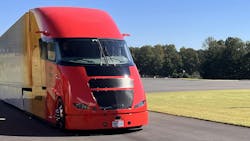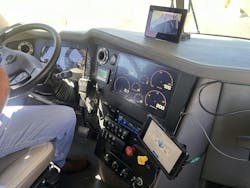Shell launches Starship 3.0 with major efficiency gains in an ICE package
LEEDS, Alabama—Just how efficient can a fully loaded Class 8 tractor-trailer be?
Shell sought to answer that question when designing its Starship 3.0, a Class 8 concept equipped with readily available technology in today’s trucking market. The initiative, now in its third generation, helps prove that peak freight efficiency doesn’t require building a truck from scratch; it simply requires tweaking what’s current.
Shell's Starship initiative launched in 2018 and took on its name because the vehicle resembles a spacecraft. The first generation, hauling 39,000 lb. over 2,300 miles, achieved 8.94 mpg, compared to the 6.4 industry average. The Starship has improved since then with the Starship 2.0 and now the Starship 3.0.
Shell Starship 3.0 surpassed the efficiency gains of its predecessors, achieving 2.542 times better freight ton efficiency on a ton-miles per gallon basis and 3.23 times better freight ton efficiency assessed on a ton-miles per kg of CO2e emitted basis, according to Shell. Additionally, it achieved 9 mpg (diesel gallon equivalent) while hauling the industry maximum 80,000 lb. Test results were validated by the North American Council for Freight Efficiency.
See also: 3rd-gen Shell Starship posts big efficiency, emissions gains
Shell displayed its third-generation Starship at the Barber Motorsports Park and Museum here in Alabama and detailed how it achieved its most fuel-efficient Starship yet.
Shell Starship 3.0 features
A plethora of factors contribute to a truck’s fuel efficiency, such as the load type, weather, road conditions, and driver behaviors, to name a few. But the truck’s powertrain, design, and tires also affect its fuel efficiency. These are the features the Starship initiative addresses.
Shell Starship 3.0: powered by natural gas
What distinguishes the Starship 3.0 from its predecessors that isn’t immediately apparent is its new powertrain. Instead of using a diesel engine like in the first two Starship generations, Shell opted for a Cummins X15N, a natural gas engine, to power its Starship 3.0.
The Shell Starship team chose the Cummins X15N after considering alternatives to diesel. Though a hydrogen powertrain was on the table, after weighing the prevalence of infrastructure and the ability to refuel while traveling, Heather Duffey, global integrated communications manager for Shell Commercial Road Transport Lubricants, said Shell decided a natural gas engine would be best suited for its Starship 3.0.
“We decided that [natural gas] was the right choice for us because it's something that fleets can adopt now, instead of some future, far off ‘what if,’” she explained.
Different from diesel engines, natural gas engines run hotter, and they’re slightly less efficient, Mike Roeth, NACFE executive director, told FleetOwner at the event.
But Kevin Otto, NACFE’s electrification team lead, said that even considering that efficiency decrease, a natural gas engine pulling the same load as a diesel engine produces significantly fewer emissions, some 15% fewer, and requires less maintenance.
Moreover, Otto explained that Cummins’ new X15N performs much like a diesel engine with similar torque and horsepower ratings.
See also: What's new in Cummins' next diesel X15 engine
The Shell Starship 3.0 used a “special” natural gas 5W-30 engine oil, Duffey said, because “natural gas engines run hotter and need a different additive pack than what you would normally have in a diesel engine."
This wasn’t a problem for Shell as a global lubricant supplier. In fact, in many ways, the Shell Starship acted as Shell’s mobile test lab, Duffey explained.
Efficiency gains through less wind and tire resistance
The most noticeable difference between a traditional Class 8 truck and the Starship 3.0 is its distinctive look. The third generation Starship features a design that has carried over from each generation of the Shell Starship.
The cab, made with lightweight carbon fiber with curved edges and a sloping hood and windshield, was explicitly designed to increase efficiency through lighter weight and improved aerodynamics. Additional panels, such as a low trailer skirt, panels between the cab and the trailer that deploy at higher speeds, and panels on the back of the trailer, also help reduce wind drag.
Reducing tire friction also helped Shell achieve greater efficiency. Shell initially worked with Bridgestone to add extra-wide, low rolling resistance rear tires to its Starship 3.0 tractor, Duffey explained. However, Bridgestone recently developed a new line of low-resistance steer tires, which are currently featured on the Starship 3.0.
See also: Increase fuel efficiency through aerodynamics
The Starship experience
Because the Shell Starship 3.0 is an initiative, or a “lab on wheels,” as Duffey described it, it isn’t used as a traditional long-haul truck and therefore does not need driver convenience features, such as a bed, storage, fridge, etc. The absence of these features creates a very open interior with plenty of space.
The cockpit of the Shell Starship 3.0 isn’t too different from that of a traditional Class 8 tractor. To increase the truck’s aerodynamics, traditional driver mirrors are replaced with cameras, and monitors are located along the truck’s A pillars. Brian Rector, the Starship 3.0 driver, said although the monitors took a while to get used to, they function just as well as mirrors.
Riding the truck around a short loop at low speeds wasn’t enough to get a realistic feel of how the truck behaves on the highway, but it was enough to determine that the truck seems to drive and behave much like most Class 8 trucks on the road today. Even Rector, who’s driven the Starship 3.0 thousands of miles on real streets and highways, said the differences between driving the Starship and other trucks hasn’t been that drastic.
This proves that adding aerodynamic features, decreasing tire friction, and integrating a more efficient powertrain—all of which OEMs can implement today—contribute greatly to the efficiency of a Class 8 tractor-trailer.
A massive industry-wide overhaul isn't required to increase efficiency and lower carbon emissions. And Shell’s Starship initiative and the Starship 3.0 prove it.
About the Author
Jade Brasher
Senior Editor Jade Brasher has covered vocational trucking and fleets since 2018. A graduate of The University of Alabama with a degree in journalism, Jade enjoys telling stories about the people behind the wheel and the intricate processes of the ever-evolving trucking industry.




